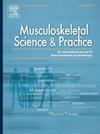慢性非特异性颈部疼痛患者的颈部肌肉大小和身体特征之间的关系:一项系统综述。
IF 2.2
3区 医学
Q1 REHABILITATION
引用次数: 0
摘要
背景:尽管有多项研究调查了慢性非特异性颈部疼痛(CNP)患者的颈部肌肉结构,但关于颈部肌肉大小与通常评估的身体特征之间关系的研究结果并不一致,这突出了对现有证据进行系统综合和评估的必要性。目的:本系统综述探讨了颈肌大小与CNP患者颈部力量、耐力、运动范围、本体感觉和头部姿势等通常评估的身体特征之间的关系。方法:系统检索MEDLINE, EMBASE, PubMed, CINAHL Plus和Web of Science自成立至2024年10月21日。纳入的研究集中在患有CNP的成年人身上,检查颈部肌肉形态和身体特征之间的相关性。排除标准包括外伤性颈部疼痛、颈部手术和神经根病。偏倚风险采用改良的纽卡斯尔-渥太华量表进行评估,证据的确定性采用推荐、评估、发展和评估分级(GRADE)方法进行评估。采用叙述性综合方法来总结研究结果。结果:在5912份确定的记录中,包括8项研究,包括246名参与者。对纳入研究的叙述综合发现,颈长肌和头长肌的横截面积(CSA)与颈部耐力、颈长肌CSA与颈部本体感觉、以及颈长肌CSA与体位摇摆测量之间存在显著相关性。结论:基于非常低确定性的证据,颈部肌肉尺寸减小与CNP患者的下颈部耐力、本体感觉改变和姿势摇摆增加有关。注册号:CRD42024570776 (PROSPERO)。本文章由计算机程序翻译,如有差异,请以英文原文为准。
Association between neck muscle size and physical features in individuals with chronic non-specific neck pain: A systematic review
Background
Despite multiple studies investigating neck muscle structure in people with chronic non-specific neck pain (CNP), findings on the relationship between neck muscle size and commonly assessed physical features are inconsistent, highlighting the need for systematic synthesis and evaluation of the available evidence.
Objective
This systematic review examines the association between neck muscle size and commonly assessed physical features including neck strength, endurance, range of motion, proprioception and head posture in individuals with CNP.
Methods
A systematic search was conducted across MEDLINE, EMBASE, PubMed, CINAHL Plus, and Web of Science from inception to 21 October 2024. The included studies focused on adults with CNP, examining the correlation between measures of neck muscle morphology and physical features. Exclusion criteria included traumatic neck pain, neck surgery, and radiculopathy. Risk of bias was assessed using a modified Newcastle-Ottawa Scale and the certainty of evidence was evaluated using the Grading of Recommendations, Assessment, Development, and Evaluations (GRADE) approach. A narrative synthesis was used to summarise the findings.
Results
Of the 5,912 identified records, eight studies were included, comprising 246 participants. The narrative synthesis of the included studies identified significant correlations between the cross-sectional area (CSA) of longus colli and longus capitis with neck endurance, longus capitis CSA with neck proprioception, and longus colli CSA with measures of postural sway.
Conclusions
Based on very low certainty of evidence, reduced neck muscle size is associated with lower neck endurance, altered proprioception, and increased postural sway in individuals with CNP.
Registration number
CRD42024570776 (PROSPERO).
求助全文
通过发布文献求助,成功后即可免费获取论文全文。
去求助
来源期刊

Musculoskeletal Science and Practice
Health Professions-Physical Therapy, Sports Therapy and Rehabilitation
CiteScore
4.10
自引率
8.70%
发文量
152
审稿时长
48 days
期刊介绍:
Musculoskeletal Science & Practice, international journal of musculoskeletal physiotherapy, is a peer-reviewed international journal (previously Manual Therapy), publishing high quality original research, review and Masterclass articles that contribute to improving the clinical understanding of appropriate care processes for musculoskeletal disorders. The journal publishes articles that influence or add to the body of evidence on diagnostic and therapeutic processes, patient centered care, guidelines for musculoskeletal therapeutics and theoretical models that support developments in assessment, diagnosis, clinical reasoning and interventions.
 求助内容:
求助内容: 应助结果提醒方式:
应助结果提醒方式:


